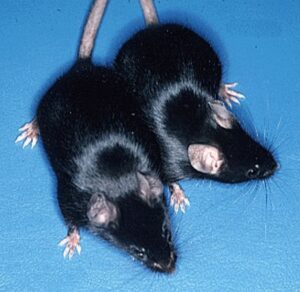Our blacks of today are very black. Sure, we’re fighting against every non-black hair, and those who breed blacks know it is a fight you cannot win. What we see on the show bench are those specimens that exhibit the least amount of non-black hairs and, if you show at the right time, it can be an almost flawless mouse. Almost, but never quite perfect.
We know of an extreme nonagouti gene that will allegedly suppress all non-black hairs. Here is an excerpt from Silvers’ “The Coat Colours of Mice”: ‘Extreme non-agouti (ae) was found among the descendants of an irradiated mouse (Hollander and Gowen, 1956). It is recessive to all the other alleles of the agouti series and is characterized as completly eumelanotic— i.e., no yellow hairs occur on or behind the ears or around the nipples and perineum.’ What we know in the fancy as black, to geneticists is ‘non-agouti’ but let’s not get lost in terminology.
Despite claims by various groups on the internet and social media that they are in possession of such mice, we can be quite certain that the gene is not available, nor has it ever been, to nonscientists. This somewhat sweeping statement is easy to prove by pure logic. Read on. The only occurrence of this gene is in the form of tiny frozen embryos at Jackson Labs in the state of Maine, USA and a few other places where they keep strains of mice for scientific purposes. Interestingly, when you look at the comparison image on the Jax website, where a ‘standard’ black mouse is shown next to an ‘extreme non-agouti’, you can see hardly a difference.

Extreme Non-agouti (left), Black (right)
Skin pigmentation is slightly stronger but both mice have light feet and toenails. Unfortunately, no belly shot is available, where I would expect to see a stronger difference, because of the absence of yellow hairs in the extreme non-agouti specimen. But I cannot be certain. You might think this extreme black gene is not all it’s cracked up to be, but there is a chance it might live up to the promise.
Our UK show blacks have been selected for hundreds of generations, for blackness. Despite their inferior genetic makeup (in comparison with extreme blacks), they are much blacker than the ‘extreme’ lab stock. So, what would happen if we could combine the modifiers we have selectively bred into our blacks with the extreme black gene? I would imagine, that this would give us extremely beautiful show blacks within just a few generations of selective breeding. And here comes the logic that makes any claims of possession of extreme blacks unlikely: say you had successfully sourced a trio of extreme blacks from a lab. How would you go about introducing the intensifiers into the lab stock? As soon as you start breeding the extreme blacks to your show blacks you have lost the game. Crossing ae/ae mice with aa mice will result in ae/a mice and from there on, there is no way of telling what you are looking at. Remember the lab stock has far inferior colour and any first offspring derived from a cross will be an awful looking bunch. Even if you cross back to the extreme black parents, there is no way of telling what you are looking at, genetically. Nobody who has claimed to have these extreme blacks, has ever discussed where they originated, or produced any genetic evidence by way of a genetic test (which would be easy and relatively cheap to do).
So, how would one go about mixing the black intensifiers of our show stock into the lab stock then? There are two safe ways I can think of: tans or agoutis. Both tan (at) and agouti (A) is dominant to non-agouti and can hence be safely combined with ae. There would need to be several generations of preparations, breeding agoutis or tans to a show line of blacks, breeding the agouti or black tan offspring back to the show blacks for several generations until all of the modifiers have accumulated. What you would get are awful looking, very dark Agoutis or lacklustre black tans. But you would always be looking at A/a or at/a mice, which you could safely cross with ae/ae mice, as long as you only keep the agoutis and tans for further breeding. So, any agouti or tan mice from that cross would HAVE to be A/ae mice or at/ae mice. The only safe way to proceed would be to cross siblings, which would give you 25% ae/ae offspring and you could be 100% certain that all self blacks from those litters would genetically be extreme non-agoutis. You would have to repeat crossing these back to the darkened tans or agoutis for a few generations but in the end, what you would get would be show-blacks with a new genetic makeup.
My assumption is that this would vastly improve our black show stock but also any siamese, blues and, of course, chocolates! The problem is: we can’t get them. Research labs do not trade mice. They only supply to other research institutes but not fanciers. I was almost successful last year, filling out a lot of forms but in the end they declined my order. We’ll get there in the end, I am quite certain.
 We use cookies to ensure that we give you the best experience on our website. If you continue to use this site we will assume that you are happy with it.
We use cookies to ensure that we give you the best experience on our website. If you continue to use this site we will assume that you are happy with it.
0 Comments